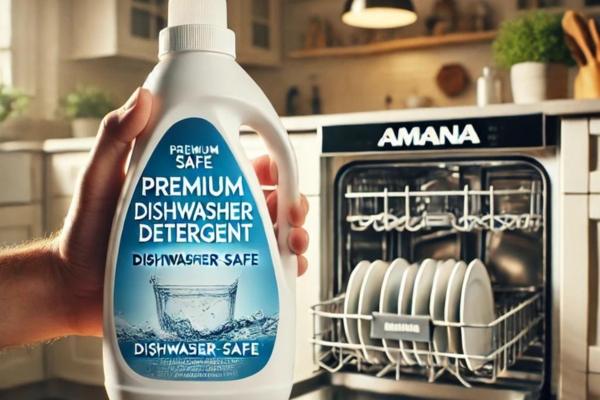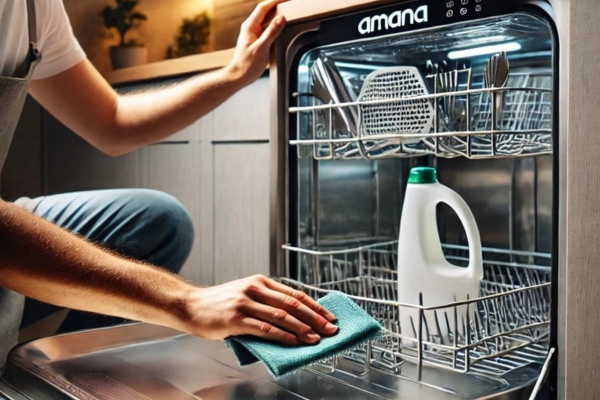An Amana dishwasher is more than just a kitchen gadget—it’s a transformation of daily chores. From scrubbing dishes by hand to effortlessly loading them into a machine, it simplifies one of the most mundane tasks. With a reputation for dependability and efficiency, Amana dishwasher work are designed to be intuitive. Whether this is your first foray into the world of dishwashers or you’re switching to Amana, understanding how it works is essential. Mastering its features, knowing the settings, and troubleshooting basic issues will save you not only time but also the mental hassle of dish duty.
Getting Started: Unpacking And Setting Up Your Amana Dishwasher

Unpacking your new Amana dishwasher feels like unwrapping a gift of convenience. Carefully remove the packaging to avoid missing any small yet crucial parts. Inspect the unit meticulously for any shipping damage before getting started. Once out of the box, check the installation guide. Ensure that all hoses and connections are secure, as a simple oversight can lead to leaks or malfunctions later on. Finally, leveling the dishwasher is paramount—not only does it keep water flow in check, but it also prevents unnecessary vibrations that could make the machine sound like it’s preparing for lift-off.
Understanding The Parts Of A Amana Dishwasher
The control panel is the command center of your Amana dishwasher, putting all the power of the appliance at your fingertips. It’s where you select cycles, adjust temperatures, and fine-tune settings. Equally vital is the detergent dispenser, which releases cleaning agents at the perfect time, ensuring every dish is touched by soap. Inside, the spray arms rotate with calculated precision, spraying water evenly to cover each item. Filters capture the residue, preventing food particles from re-circulating. Keeping these components in good condition is key to peak performance.
Choosing The Right Dishwasher Detergent

Not all detergents are created equal. When it comes to Amana dishwashers, the right detergent makes all the difference. Specially formulated for these machines, dishwasher-safe detergents dissolve completely, leaving no residue. On the contrary, regular dish soap can create foam overload, potentially damaging your unit. Follow manufacturer recommendations, and always avoid the temptation of shortcuts. A premium detergent equals sparkling clean dishes, and consistency is the secret ingredient.
Loading Dishes Properly: Maximize Space And Efficiency

There’s an art to loading dishes in a way that maximizes both space and cleaning power. The top rack is a sanctuary for cups, mugs, and smaller items, while the bottom rack is the home for bulkier items like pots, pans, and dinner plates. By strategically placing these larger items, you ensure they don’t block the spray arms. And don’t forget the silverware basket—place utensils handle down for better exposure. The more space you leave between items, the cleaner they’ll be. It’s a balancing act between efficiency and thoroughness.
Selecting The Best Wash Cycle For Your Needs

Different situations call for different wash cycles. Amana dishwashers offer several cycles to suit your every need. The Normal Cycle is your everyday go-to—efficient and effective. Heavily soiled items? The Heavy Cycle increases the water pressure and temperature, powering through stuck-on food. And for those days when time isn’t on your side, the Quick Wash Cycle gets the job done in a flash, taking care of lighter loads with minimal effort. Selecting the right cycle ensures you get the best results without wasting energy or water.
Customizing Your Wash With Additional Settings

For those times when you need a little more control, Amana dishwashers offer several custom settings. The Delay Start feature allows you to run the dishwasher at a time that suits your schedule. Whether you’re looking to save on energy bills or simply want the convenience of a later cycle, it’s a handy option. The Eco-Friendly Mode is a favorite for those looking to reduce their environmental footprint—it conserves water and energy while still giving a thorough clean. And for particularly dirty or greasy dishes, the High-Temperature Wash provides an extra layer of sanitation, eliminating any lingering bacteria.
Adding Rinse Aid For A Spot-Free Finish

Rinse aid is the unsung hero of dishwasher success. It prevents those pesky water spots and streaks that can mar an otherwise perfect load of dishes. By reducing the surface tension of water, it allows water droplets to glide off smoothly, leaving dishes sparkling clean. Filling the rinse aid dispenser is easy, and a little goes a long way. Just be sure to check the levels regularly and refill as needed for optimal results.
Monitoring The Wash Cycle: What Happens Inside

Inside your dishwasher, a well-coordinated series of actions is taking place. Water fills the basin and mixes with detergent, creating a powerful cleaning solution. Rotating spray arms ensure every corner of every dish is hit with a jet of soapy water. The machine heats the water to just the right temperature, carefully regulating the pressure to avoid damaging fragile items. Each phase—from the initial soak to the final rinse—plays a critical role in delivering perfectly cleaned and sanitized dishes.
Unloading Your Dishes: Tips For Best Results

When the wash cycle ends, patience is a virtue. Begin unloading with the bottom rack to prevent any stray water from the top rack from splashing onto your clean dishes below. For glassware and other delicate items, give them a moment to cool down to avoid thermal shock. As you unload, check for any stubborn food particles or water spots and give them a quick rinse if needed.
How To Troubleshoot Common Issues
Even the most reliable appliances encounter occasional issues. If your Amana dishwasher isn’t draining properly, check for clogged filters or a blocked drain hose. Dirty or spotted dishes could mean you’re overloading the dishwasher or using insufficient detergent. The control panel may also flash error codes—these codes offer valuable clues as to what might be going wrong. Always consult the user manual for guidance, but many problems can be resolved with just a bit of patience.
Cleaning And Maintaining Your Amana Dishwasher

Routine maintenance is essential for keeping your dishwasher running smoothly. Start by cleaning the filter regularly to prevent blockages. Every now and then, remove and inspect the spray arms for clogs. Wipe down the interior walls to eliminate residue buildup that could affect the dishwasher’s performance. By dedicating a small amount of time to maintenance, you can ensure your dishwasher provides years of reliable service.
Preventing Dishwasher Odors: Keeping Your Dishwasher Fresh

If not cleaned regularly, dishwashers can develop an unpleasant odor over time. Avoid this by running a cleaning cycle with vinegar or baking soda every month. This will help remove any lingering food particles or grease trapped in the machine. Additionally, cleaning the filter and ensuring that no food is left behind in the appliance will prevent bad smells. Keeping the door slightly open between uses can also help promote airflow and avoid a musty smell.
How To Conserve Water And Energy While Using Your Dishwasher
Amana dishwashers are designed to be energy-efficient, but there are ways you can take it a step further. Running full loads, rather than half-full cycles, maximizes the efficiency of each wash. Avoid pre-rinsing dishes; the dishwasher is designed to handle small food remnants, so no need to waste water. Lastly, using the Eco Mode can further reduce water and energy consumption without sacrificing performance.
Understanding The Warranty And Customer Support Options
Amana offers a manufacturer’s warranty that covers parts and specific repairs. Be sure to register your appliance after purchase to take full advantage of this coverage. If something goes wrong that you can’t fix through troubleshooting, customer support is ready to assist. Keep your warranty and receipt handy so repairs can be handled quickly and efficiently.
When To Call A Professional For Repairs
For more serious issues—such as persistent leaks or electrical malfunctions—it’s best to call a professional technician. Attempting to fix such problems on your own can lead to further damage or void your warranty. When in doubt, always go with a licensed and authorized Amana technician to ensure your dishwasher is repaired to the highest standards.
Upgrading Or Replacing Your Dishwasher: What To Consider
There may come a time when you need to upgrade or replace your Amana dishwasher. Newer models come with advanced features such as smart controls, adjustable racks, and even quieter operation. Energy-efficient dishwashers not only offer superior cleaning power but also lower your utility bills. Keep an eye on evolving technologies that could make dishwashing an even easier and more seamless experience.
How Often Should I Clean The Dishwasher Filter?
The dishwasher filter should ideally be cleaned once a month to ensure efficient performance and prevent clogs. Over time, food particles and debris can accumulate in the filter, reducing the dishwasher’s ability to clean effectively and potentially causing unpleasant odors. If you use your dishwasher frequently or notice residue on dishes, cleaning the filter more often may be necessary. Regular maintenance not only keeps your dishwasher running smoothly but also extends its lifespan by preventing unnecessary wear and tear.
Can I Use My Amana Dishwasher For Washing Fragile Glassware?
Yes, you can safely use your Amana dishwasher for washing fragile glassware, but it’s important to use the appropriate settings. The delicate or glassware cycle is specifically designed for these types of items, using lower water pressure and gentler temperatures to avoid damage. Proper loading is also crucial; place glassware securely in the top rack, ensuring they don’t touch each other to prevent chipping or breaking during the wash. With the right care, your Amana dishwasher can clean your fragile glassware thoroughly while keeping them intact.
What’s The Best Way To Remove Tough Food Stains From Dishes?
The best way to remove tough food stains from dishes is to pre-soak them in warm water mixed with a small amount of dish soap before placing them in the dishwasher. This helps loosen hardened or baked-on food residue. When loading into your Amana dishwasher, choose the Heavy Cycle or High-Temperature Wash setting, which uses increased water pressure and heat to break down stubborn stains. For especially difficult stains, adding a quality dishwasher detergent or a booster like vinegar can enhance cleaning power. This method ensures even the most persistent food stains are thoroughly removed, leaving your dishes spotless.
Conclusion
Using an Amana dishwasher properly not only gives you consistently spotless dishes but also makes your kitchen routine significantly easier. With just a little care and maintenance, you can enjoy the peace of mind that comes with knowing your dishwasher is working at peak performance. Take advantage of the convenience, and let your Amana dishwasher take care of the mess while you focus on what truly matters.
